Slow
Conversations
Issue: On Psychogeographies
Issue: On Psychogeographies
Driven by first-hand experiences of migration and diaspora, the multi-disciplinary practice of Boedi Widjaja (b. 1975, Indonesia/Singapore) articulates subtle reflections on memory, spatial relations and cross-cultural hybridities. He received the Singapore Art Museum and QAGOMA co-commission for Black—Hut, Black—Hut (2018-19), for the 9th Asia Pacific Triennial and 6th Singapore Biennale. Recent solo exhibitions include Declaration of (2019), Helwaser Gallery, New York; and Rivers and lakes Tanah dan air (2018), ShanghART Singapore.
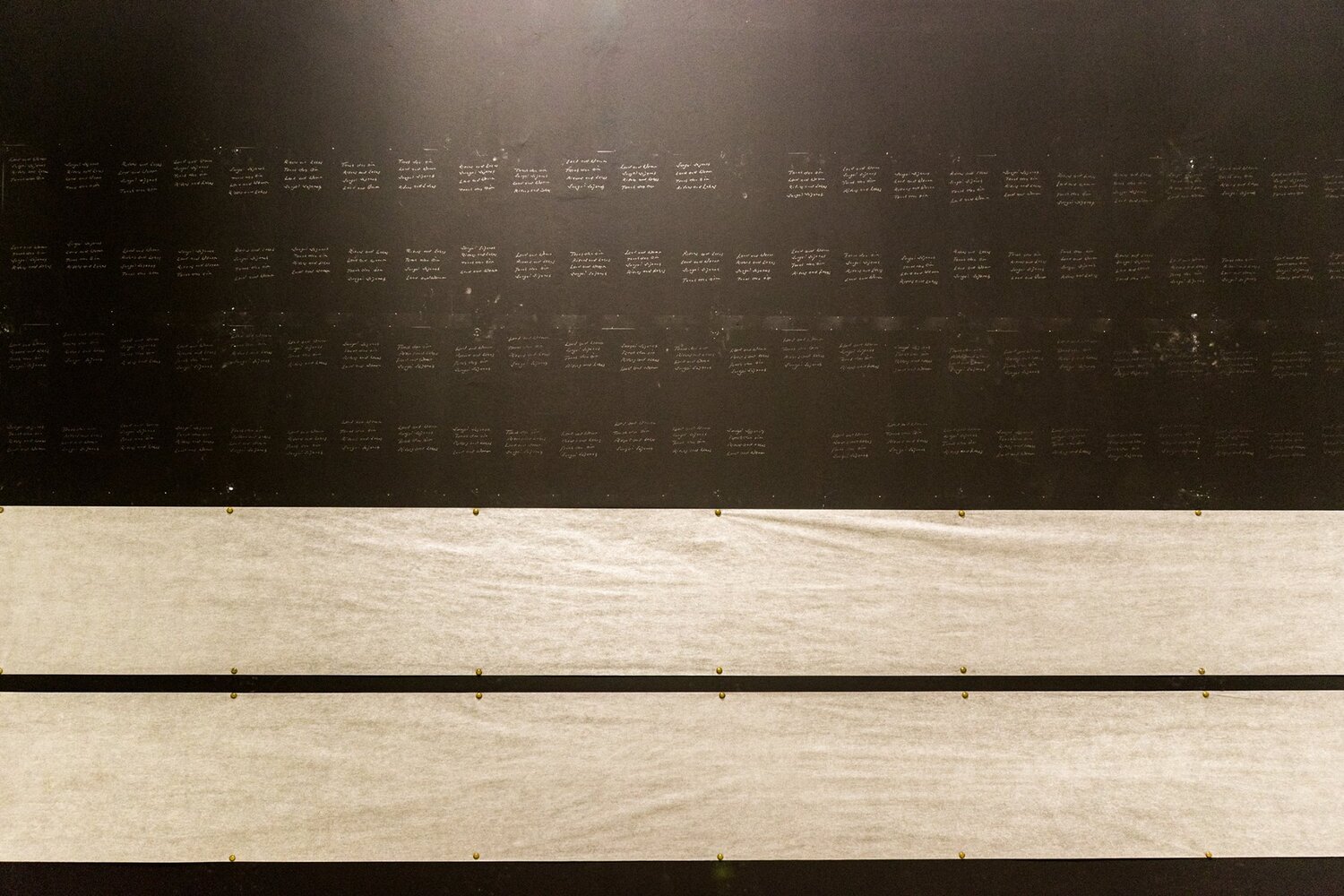
Let’s open our conversation with a poem you
composed, and something that you found yourself drawn towards highlighting for
our conversation. Tell us more about the poem and the context under which it
was written.
I wrote this poem for a live performance that I did in 2019 at ShanghART Singapore. At that time, I was thinking about how I could use the journal my late paternal grandfather left behind. During the last few years of his life, my paternal grandfather stayed with my family. The idea for writing that poem came about as I read his journal and looked at his writing. Both my grandfather and I share a diasporic story of sorts. He migrated from Fujian, China in his youth and was adopted into a different family. As a result, he changed his family name to travel with them to Indonesia as a family member. As for me, I traveled to Singapore at a rather young age. I made the trip with my elder sister and without our parents. Hence, I was keen to draw a metaphorical line from my grandfather to me. In order to do that, I felt that I needed to write something – just as he did. The poem came about through that thought process, and the poem reads:
Rivers and lakes,
Tanah dan air,
Land and water,
Sungai sejarah.
It contains place imaginaries that I would like to think both my grandfather and I have experienced in our respective journeys to foreign lands.
¹ Rivers and lakes Tanah dan air, Boedi Widjaja
2018, Performance at ShanghART Singapore
² Rivers and lakes Tanah dan air, Boedi Widjaja
2018, Performance at ShanghART Singapore
² Rivers and lakes Tanah dan air, Boedi Widjaja
2018, Performance at ShanghART Singapore


The poem is written in two different languages,
both of which have unique nuances and characteristics of their own. Considering
the bilingualism of this poem, how would you begin to describe the way in which
an intimate understanding of language or text has shaped your practice?
There are three languages in the poem, although the literal expression of the poem was made in two languages. The first line, “Rivers and lakes”, for example, was meant to evoke the Chinese term, 江湖 (jiang hu). If you translate that into Bahasa Indonesia, you get the term kang ouw. If we take the conjunctions out of each line in the poem, you get a completely different concept of a place. It also brings to mind the elements that we experienced sensorially in a geographical place in an indirect and literary manner.
A popular Indonesian writer of martial arts novels, Kho Ping Hoo, happened a neighbor of mine from my hometown. I didn’t know about this, and only found out about this much later. My uncle told me that Kho Ping Hoo lived in a small cluster of houses a few streets away from my family home. Growing up, my uncle could sometimes hear the sound of the small printing press that he operated. I grew up watching a lot of Chinese martial arts films. At that point in time, there wasn’t a wide selection of Chinese cultural offerings in Indonesia. Many of these martial arts films came to us in the form of VHS tapes, and most of them came from Singapore. In fact, they were pirated copies that were then brought to Indonesia and distributed to different parts of the country. I found this imagined community of righteous swordsmen who helped the poor and weak quite fascinating. An important element of 江湖 (jiang hu) is how the swordsmen wander and travel from one place to another. There is this dimension of the itinerant and the nomadic, and of course, I was also drawn to the action-packed martial arts scenes as a young boy.
The second line of the poem is “Tanah dan air”. If you take the word “dan” – which means “and” in English – out, “tanah air” means homeland. It means nation. This is another place imaginary that I think about a lot in my practice, and for obvious reasons. “Land and water”, in Chinese again, is written as 水土 (shui tu). What I wanted the poem to convey was how one might feel uneasy or displaced when arriving at a new place. In fact, in Chinese we have a phrase for this: 水土不服 (shui tu bu fu). It refers to a certain level of unease, or incompatibility even, with your physical environment. It could result in physical discomfort or illness. The last line of the poem, “Sungai sejarah”, refers to the great rivers that are central to many Asian creation myths. The Yellow River, for example, is often described as being the very beginning of Chinese civilization. In general, rivers paint a very vivid picture of movement and flow for me. As a physical representation of place, that appeals to me greatly.
Language is interesting for me because I don't really have a first language. I was born in Indonesia, and Bahasa Indonesia remains a very deeply embedded language in my heart. Yet I wouldn't say that I know the language intimately. I left the country when I was nine years old, and although I still speak it within my family, I never could deepen my relationship with the language further. Chinese is another language I have a fraught relationship with because it is not a language that I have mastered. In fact, I would consider my grasp of the Chinese language quite lacking. However, I feel a cultural closeness to the Chinese language simply because I grew up thinking about it a lot. It is a language that is so tied to my cultural identity growing up in Indonesia. It was underscored, in that sense, through the socio-political condition that I was in at the time. English is the language that I am most proficient in. However, I wouldn’t consider my relationship with the language as a very deep one. I do not really feel for it. Out of the three languages I’ve mentioned, English is simply is the language that I can best express my thoughts in. I think about ideas in English, but when it comes to the sentiments or emotions that run deeper, I think either in terms of Chinese or in Bahasa Indonesia. Many a time in my art, these three languages surface, and this often reveals the relationships that I have with each of them.
Many a time in my art, these three languages surface, and this often reveals the relationships that I have with each of them.
³ Black—Hut, Black—Hut, Boedi Widjaja
2018-2019, Installation View at
Queensland Art Gallery
⁴ Black—Hut, Black—Hut, Boedi Widjaja 2018-2019, Installation View at Queensland Art Gallery
⁴ Black—Hut, Black—Hut, Boedi Widjaja 2018-2019, Installation View at Queensland Art Gallery
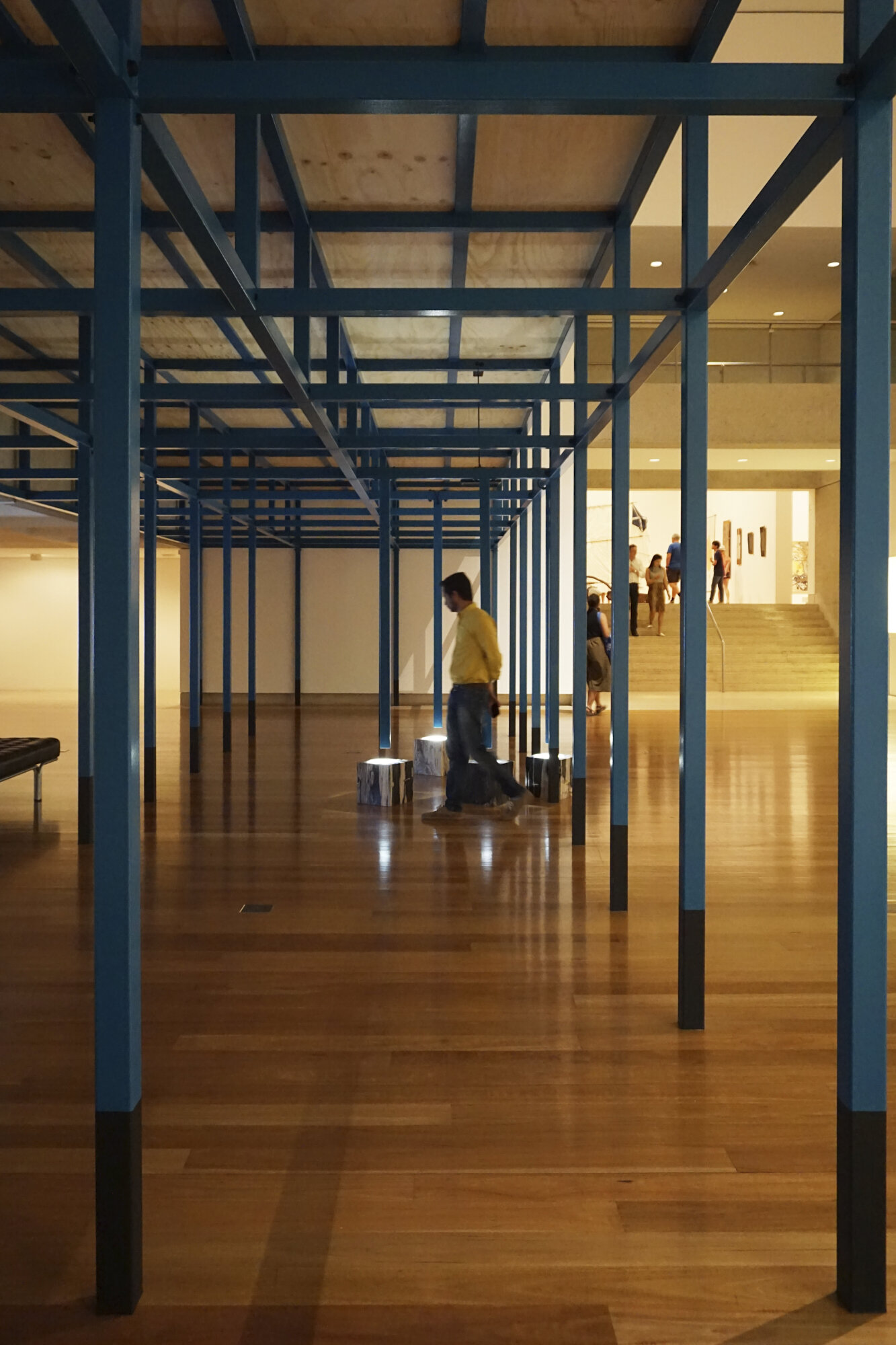
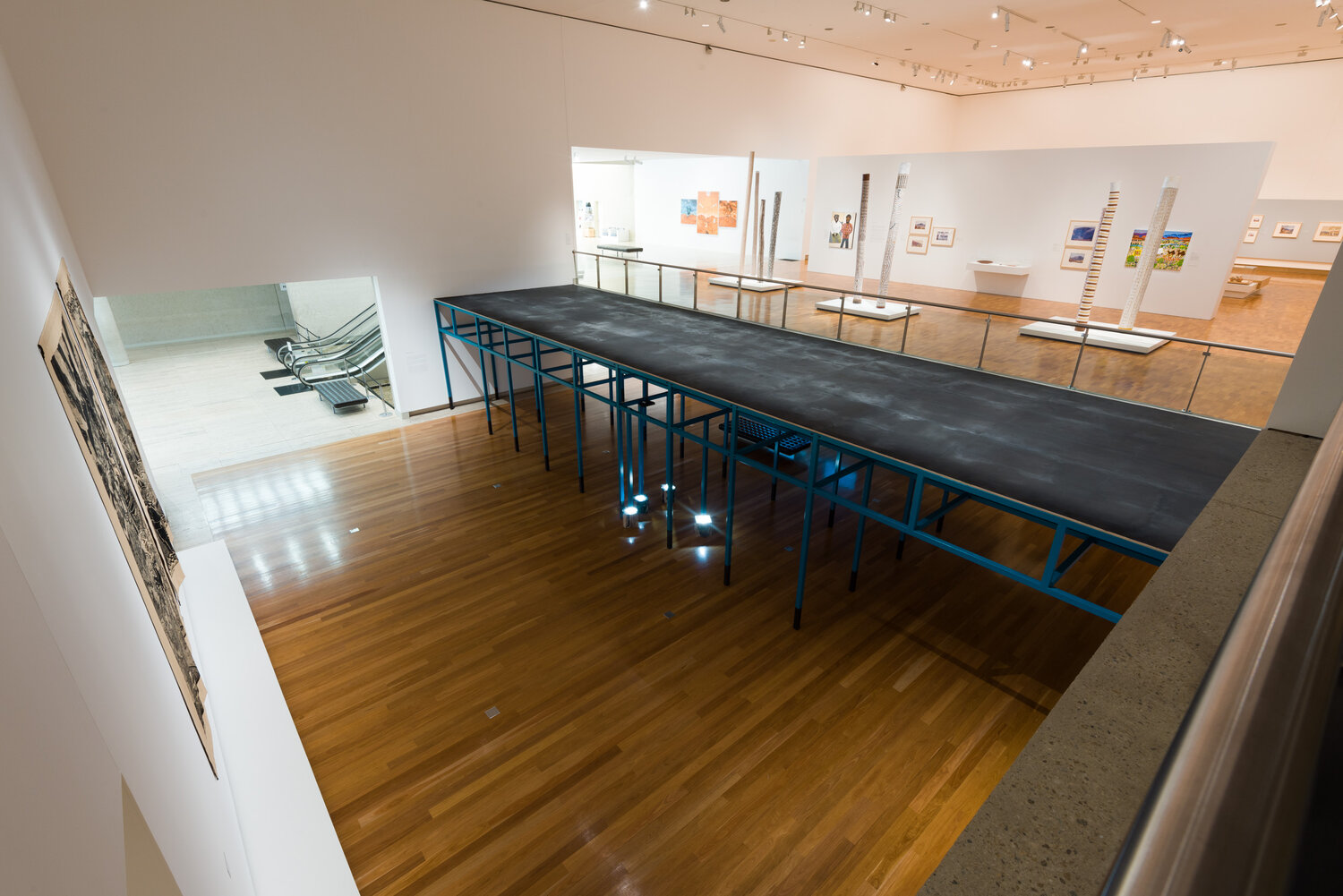
Landmarks, such as man-made architectural structures and geological formations, emerge prominently across a few of your works. In particular, I’m thinking about Rivers and lakes Tanah dan air, which we have been discussing, and other works such as Black—Hut, Black—Hut. Given your background in architecture, how have these landmarks served as a point of reference for you throughout your practice? Do you see them as mooring points, spaces of liminality, or something else altogether?
To me, the landmarks you’ve referenced in your question are both mooring points and spaces of transitions. When I think of Black—Hut, Black—Hut, which explores the notion of place by way of the architectural, I think of the structures that I have made as metaphorical tents. These were not permanent installations, and each iteration responded to each of site in a very intimate manner. There was this tension in that the works evidenced a clear desire to respond to where they were situated, but they were all temporary fixtures that would soon be uprooted. This comes back to my earlier point about structures as both a mooring point and a space of transition. Every time my work touches on notions of place, there's always the dual presence of the mooring point and the liminal. There is, on one hand, that desire to put down roots in a place. Yet there's also an impulse to move on from there. It's a paradox.
How does architecture play into this? Architecture allows me to approach this paradox through the language of construction or of materials. In the case of Black—Hut, Black—Hut, I worked primarily with concrete. I infused the concrete with salt. Over the course of the exhibition, the material responds to the tropical climate as salt crystals appear on the surface of the concrete. The concrete was applied over the temporary structure as a veneer, a skin, or a membrane. This is in stark contrast to how concrete is usually used in construction. In those contexts, it is expressed as a prominent, thick, muscular, and unchanging material. Architecture has given me the necessary language – visually, materially, and spatially – to think about space and place.
Architecture has given me the necessary language – visually, materially, and spatially – to think about space and place.
Let’s turn the conversation towards the Path.
series of work you’ve made. Could you please set the scene for us as to how
this series came to be? Was there a particular point of genesis for this
series?
The first work I made in the Path. series was done in 2012. It is very poignant to speak about it now because it was commissioned by The Substation as part of their annual Visual Art Open Call. At that point, I had just become a Singaporean. I had applied, and thankfully, succeeded in getting Singaporean citizenship. I remember that the experience of receiving citizenship did not translate quite how I thought it would. I expected to feel more rooted in Singapore. After all, I came here as a child, grew up here, had friends here, and established a family here. I remember there being a national debate around the presence of foreigners in Singapore then. I wanted to contribute positively to that conversation and dig deeper into these feelings I had about my sense of identity and belonging. Path. came out of that impulse and has grown into several works since.
⁵
Black—Hut, Black—Hut, Boedi Widjaja
2019-2020, Installation View at
National Gallery Singapore
⁶ Black—Hut, Black—Hut, Boedi Widjaja 2019-2020, Installation View at National Gallery Singapore
⁶ Black—Hut, Black—Hut, Boedi Widjaja 2019-2020, Installation View at National Gallery Singapore
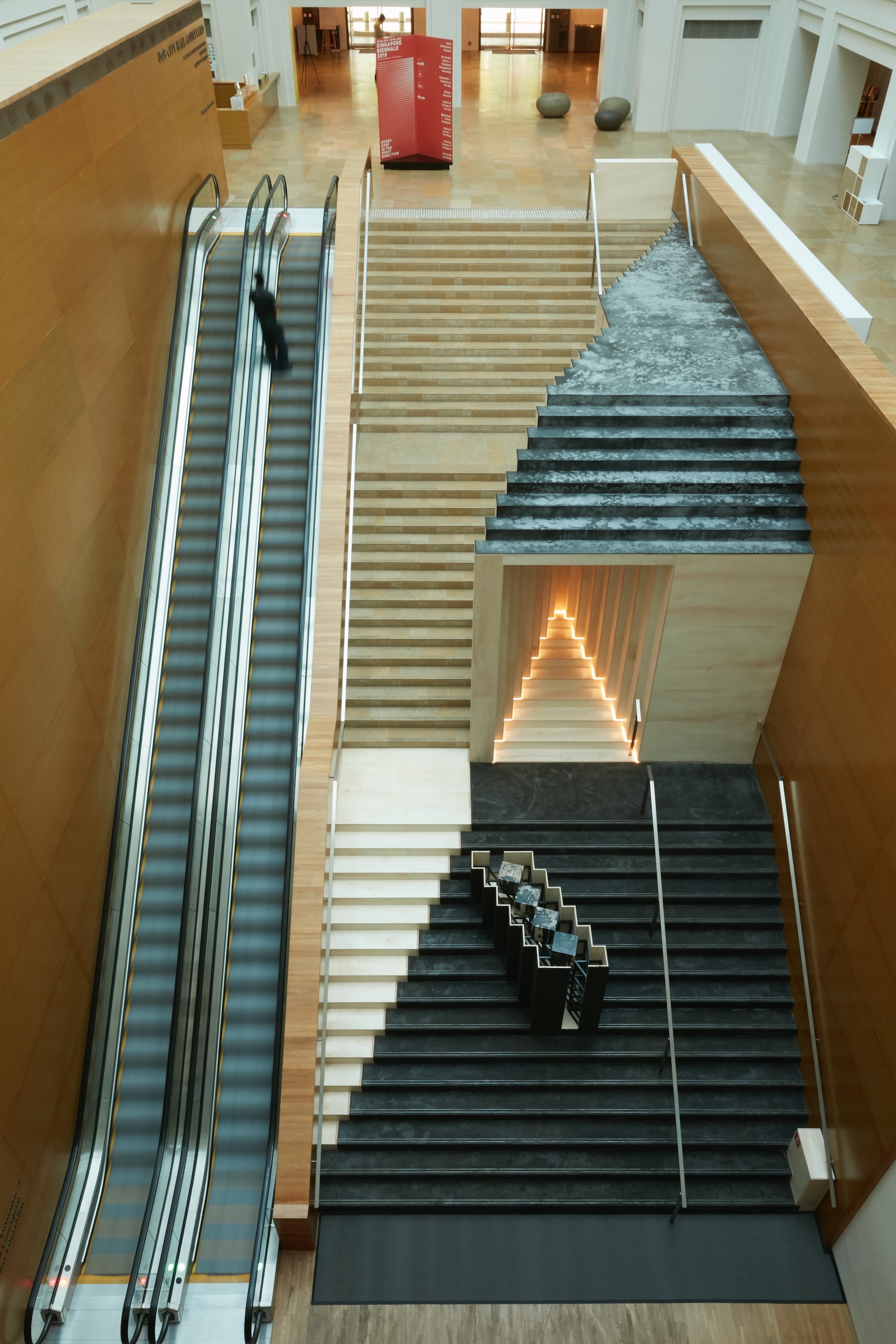

As you’ve mentioned, the Path. series has
unfolded into various iterations. Most recently, it was staged for the Asian
Film Archive in 2018. It requires a certain amount of stamina and determination
to grapple with such questions in a sustained manner. What have you enjoyed
most about a long-term engagement with these provocations, especially given the
fact that this project has been presented across various settings, countries,
times, and contexts?
Instead of thinking about the different Path. projects along a linear timeline, perhaps it would be more interesting to think about each work as circling around a centre. That centre is something I’ve often described as a void. It is a kind of opening, a clearing that is unseen, and yet it exerts its presence strongly. I imagine each circling around that void to be a gesture towards engaging with it, acknowledging its presence, but also responding to it by asserting one's agency. That’s what I’ve enjoyed a lot in working on this project as long-term series. With each circling around that centre, I see new possibilities, discover new things, and make new connections.
I imagine each circling around that void to be a gesture towards engaging with it, acknowledging its presence, but also responding to it by asserting one's agency.
In many ways, it almost sounds like an orbit.
You’re right. It does sound like an orbit – an orbit around a clear opening.
I’ve noticed a tendency of yours towards
working with drawing, image making, movement, and perhaps a certain level of
abstraction even. These are very different media, but they can be imprecise,
unreliable, and unruly at times — qualities that you seem to lean into. How
have you approached thinking about materials or materiality, and might these
media reflect, to some degree, the blurriness embedded within the reality of
thinking with and through notions of migration, borders, and home?
I don't think I’ve deliberately used certain techniques or media to present a kind of narrative around my experience of diaspora migration or my thinking around borders. Mark making, drawing, image making, and movement – these are all activities that I grew up with. I learned how to draw on the floor of my home by copying pictures out of comic books and art books. My father would sometimes check in on me and help me with certain details in the drawings. With mark making, there's always that desire to look for textures that appeals to my senses, and for the tactile experience of making that work. I am naturally drawn to these modes, but I wouldn't say that they represent certain narratives or ideas around travel, migration, and so forth. I would like to think of any chosen material or artistic gesture as an act of being and an act of living out one's experience, memory, and identity. Although the outcome can be communicated, deep down I don’t think that the impulse was a communicative one. I am still grappling with this in thinking about art. On the one hand, I understand that art is meaningful when there is an engagement with the audience. Yet I also sense a resistance to that. There is something quite autonomous to the act of art making itself. This is something that I'm still working out and trying to understand better within the context of my own practice.
⁷ Path. 8, Invisible Cities 。云海游, Boedi Widjaja
2017
⁸ Path. 9, ))) ) ) )), Boedi Widjaja 2018
⁸ Path. 9, ))) ) ) )), Boedi Widjaja 2018
In experimenting with different
materials and thinking of ways to present ideas, I was also intrigued by the way in which you’ve encoded a poem into a visual cipher that draws from the
language of DNA. It is also something you’ve used as a music score in your
recent film, A tree rings, a tree sings. Tell us more about your fascination
with DNA. These are methods that are often thought of as being data-driven,
accurate, and infallible. How it has lent itself to your own explorations
around genealogy and kinship?
I became interested in exploring and experimenting with DNA about two or three years ago. I came across an article in the New York Times about recent developments in the field of epigenetics, a niche domain within the study of DNA. These findings suggest that we inherit memories – or in particular the traumas – that our ancestors experienced. As somebody who is interested in topics such as belonging, roots, beginnings and so forth, I was fascinated by these findings. It was mind blowing for me to think about how the memories of people who have lived before you remain present in your body. I was drawn to how we could draw out these connections with our past.
In 2019, I had the chance to collaborate with a geneticist, Dr Eric Yap. Dr Yap is an associate professor at the Nanyang Technological University’s Lee Kong Chian School of Medicine. For our collaboration, we worked on producing a hybrid piece of DNA. The hybrid DNA was made up of three components. The first part was taken from a fragment of my Y chromosome. I did a saliva swab, and Dr Yap extracted a particular marker from my Y chromosome. My grandfather was named after the Chinese parasol tree, and the second part of the hybrid DNA was taken from the chloroplast of a Chinese parasol tree. The final part of the hybrid DNA was completely synthetic. What I mean by that is that it wasn't taken from any organic source. It was a coded text containing the title of the artwork, A tree talks, a tree walks. That’s how I started experimenting with DNA. The outcome of this collaboration was a site-specific installation at the Temenggong Artists-in-Residence. A flagpole was erected at the foot of Mount Faber, along with three flags. The three flags were visual ciphers for the title of the work. At the base of the flagpole was a mound of soil, and visitors were invited to mark the soil with a mixture of ink and synthesised DNA. At the end of the exhibition, the soil was returned to the land that it was taken from. That was a gesture of rooting oneself to the land, so to speak.
I began thinking about DNA as a language system and as a linguistic system. That’s how I came up with a system where the primary aspects of DNA, namely the 64 codons and the 22 amino acids that the codons code for, could be used to code and link two origin myths together. The first was expressed in Hanacaraka script, a traditional Javanese script. The other is a cipher of the 64 hexagrams found in the I-Ching.
It was mind blowing for me to think about how the memories of people who have lived before you remain present in your body. I was drawn to how we could draw out these connections with our past.
In hearing you speak about the way in which
this new field of study has opened up the possibility of making connections
between generations, have you thought about what access to what is enmeshed and
embedded within that subconsciousness means? This new field of study presents
us with unparalleled access to the embodied archive of our ancestors, yet I’m
wondering if there might be things that are better left unsaid – things such as
generational trauma, for example. What do you make of how this potentiality might
be reckoned with?
I can only speak from my personal experience, of course. So far, I have found it constructive to uncover these sources that you speak of, even though some of them point towards unpleasant experiences. I would like to think that we can also think of them as resources to draw upon. In moving forward, although it might be impossible to do so at times, being aware of what has happened helps me with contextualising the present. Going forward, this is how we might come up with better narratives. I think that these sources are necessary in giving weight to the new narratives that we are conjuring or weaving together. Without them, the stories that we write will lack context, and will turn out rather hollow. We might then fall into the trap of simply coopting someone else's narrative as our own. To miss out on this potential to contribute specifically and meaningfully to our lived experiences would be a shame.
⁹
Studio Documentation from Residency at NTU Centre for Contemporary Art Singapore
¹⁰ Studio Documentation from Residency at NTU Centre for Contemporary Art Singapore
¹⁰ Studio Documentation from Residency at NTU Centre for Contemporary Art Singapore
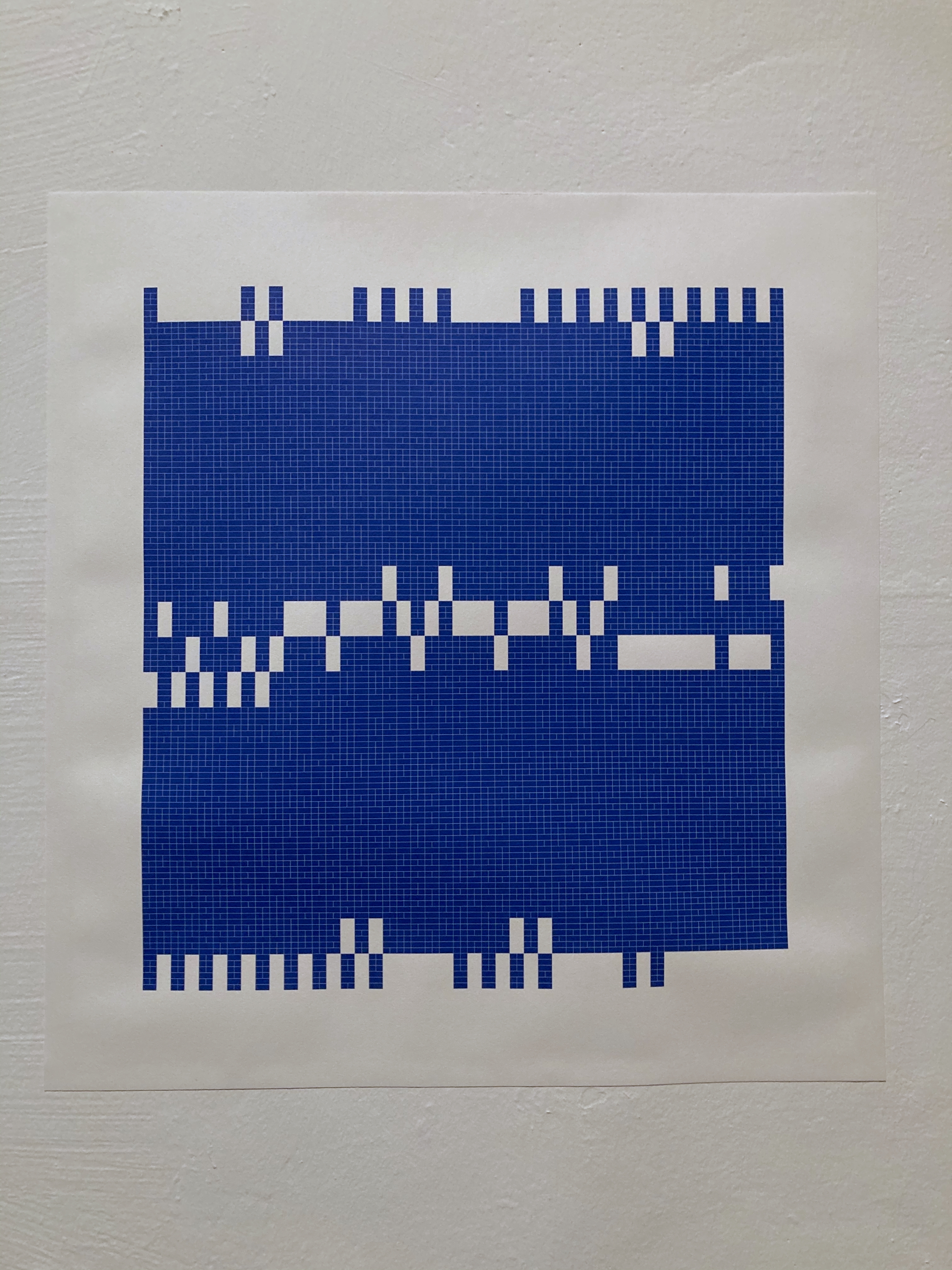

The way in which we move through or understand
space – be it domestic, transnational, or metaphysical – is now tinged by our
experience of the current pandemic. You’ve been thinking about these spaces over
the course of your practice, but how are you thinking about movement and
mobility today? Has this understanding of space condensed, expanded, or
remained relatively unchanged?
It has changed. I'm starting to think about the idea of mobility and space in terms of hybridity. I anticipate an expansion of the digital or online domains. We are, for example, having this conversation by way of Zoom right now, but I anticipate an accelerated advancement in how we interact online. In terms of physical travel, I cannot picture having the same kind of mobility that we had prior to COVID-19 – at least not for the next two or three years. As such, modes of mobility in physical space will also change quite dramatically. Having said that, humans are very resourceful creatures. Even as we speak, I believe that there are many people in the world who are thinking about this and coming up with all kinds of fantastic ideas for change and expansive possibilities. I am trying to be hopeful. I would like to imagine a day where – maybe through changes in how things are configured or how we think about what it means to travel – that we can overcome this limitation that we are facing now.
